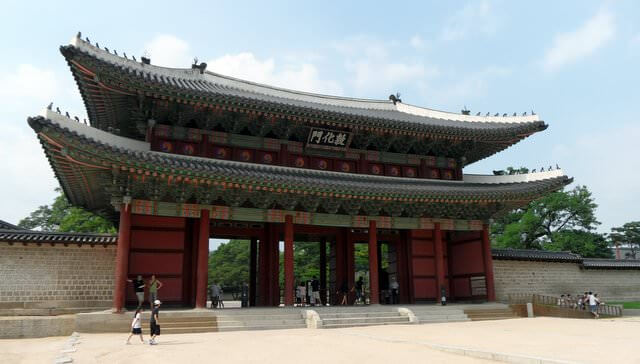
As a China tourist visa lasts 6 months, but only for stays of up to 90 days at a time, I needed to briefly leave the country to keep it valid. North Korea was a tempting prospect as it’s easily reachable by train from Beijing, but requires a lot of planning to get clearance. South Korea is just a one hour flight from China and I can get a visa on landing.
Grabbing a Jian Bing for the taxi ride we easily got to the airport and quickly boarded the plane. Unlike any plane I’ve ever been on the seat numbers started at 30, so I was half way up the plane before I realised I was way past my allocated row of 34 and had to be that annoying person who attempts to walk back against the tide of passengers desperately trying to reach a pre-assigned seat.
Not knowing a great deal about Korea in general we just followed the TripAdvisor top 5 things to do in Seoul. This led us to the Changdeok-gung palace, a UNESCO World Heritage Site. UNESCO sites are normally impressive from an aesthetic or historical point of view but I really couldn’t argue Changdeok-gung’s case on either point. The whole thing looked like a recently completed copy of whatever stood there before, mostly made of plywood. It’s got a pleasant enough Secret Garden, which is revealed for a small fee and the concubine’s house seems authentic if a little spartan.
Coming back into the centre of town on the subway was a mission. The subway trains are cheap, spacious and thankfully air conditioned, but the two interchange stations we used were huge. Both times we were unlucky enough to need the farthest platform, so crossing from one line to another entailed a hike of nearly a kilometre and down five levels of steps and escalators.
Back in the shopping district we stopped by the famous Myeongdong Gyoja restaurant for handmade noodle soup and dumplings, which were delicious but not really filling enough after all that walking.
In the afternoon we’d planned to go up Seoul tower which sits on a hill overlooking the entire city but ended up having more fun just wandering the neon-lit streets and getting a feel for the place. People here are much more polite than Beijing and whilst Westerners are still rare enough for the occasional peek they wouldn’t dream of just openly staring, and the children don’t just stand and point. In a town with no rubbish bins and no visible street sweepers it’s remarkable that the pavements aren’t lined with food wrappers and chewing gum, but people here must have pride in the city and presumably take their litter home which is a great improvement over many places I’ve visited.
It turns out that Seoul is one of the largest and most densely populated cities in the world, home to over 12,000,000 people, which more than doubles if you include the surrounding suburbs. It’s not until night time that it really comes to life with neon signs and brightly lit skyscrapers and apartment buildings filling the skyline. Even the historical sights and bridges are covered in thousands of coloured light bulbs.
The other amazing thing is the level of technology built into the infrastructure of the city. The broadband here is all 100Mbps, which is being upgraded to 1Gbps within the next two years and anyone with a modern phone will find that the city-wide Wi-Bro service allows fast internet access on the move, so you’ll often see people walking down the street watching TV on their phones. The taxis are equipped with a GPS system so accurate they know which lane you’re driving in and recommend switching before taking certain turns, as well as providing 3D real-time visualisations of the road ahead, so you can see for example that there’s a toll gate, and you should stick to the left to make a turn into a two-lane tunnel.
For the evening we went to Itaewon which seems to be the most popular area with Westerners, who are rarer than I’d expected elsewhere. The streets of Itaewon were full of Western families, ESL teachers and the lechers that follow them round. Catering to all the visitors are the usual fast food franchises so we found a small street behind the Hamilton Hotel with a row of privately owned restaurants and picked out a French bistro for a bit of a change. The starters and main courses were perfect but our stereotypically condescending French waiter did completely abandon us when some of his countrymen arrived, so dessert wasn’t a possibility, and it was even tricky to get the bill.
By now the bars were full and the music was spilling into the streets but we made our way back to the hotel at a reasonable hour in preparation for an early start the next day.





